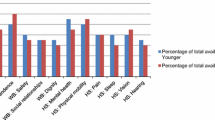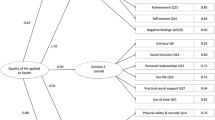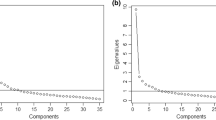Abstract
Purpose
To describe the relative importance of 38 facets of quality of life (QOL) to older adults in 22 countries, by gender, age group, and health status.
Methods
A secondary analysis of data was conducted from the WHOQOL-Old pilot study. Questionnaires were distributed by mail or in person. Independent t-tests for differences between means were calculated between importance scores by genders, age groups, and healthy/unhealthy participants. Hierarchical multiple regression analysis was used to identify which QOL facets explained importance of overall QOL.
Results
Of 7,401 older adults from 22 countries (mean 73.1 years), 57.8% were women and 70.1% were ‘healthy’. While there are significant differences in the importance of various facets of QOL on the basis of gender, age, and health status, when these variables were controlled in a stepwise multiple regression analysis, the most important QOL facets were having energy, being happy, having well-functioning senses, and being free from pain.
Conclusion
It appears that many of the physical aspects of QOL such as energy, freedom from pain, ability to do activities of daily living and to move around are particularly important to older adults. Practitioners should give greater attention to energy, sensory abilities, and pain.
Similar content being viewed by others
Abbreviations
- ADL:
-
Activities of daily living
- HDI:
-
Human Development Index
- QOL:
-
Quality of life
- SEIQoL:
-
Schedule for the Evaluation of Individual Quality of Life
- SEIQoL-DW:
-
Schedule for the Evaluation of Individual Quality of Life (Direct Weighting)
- WHOQOL:
-
World Health Organization, Quality of Life Assessment
- WHOQOL-OLD:
-
World Health Organization, Quality of Life Assessment of Older Adults
References
Fallowfield, L. (1990). Quality of life. The missing measurement in health care. London: Souvenir Press, Human Horizon Series.
WHOQOL Group. (1995). The World Health Organisation Quality of Life assessment (WHOQOL): Position paper from the World Health Organization. Social Science and Medicine, 41, 1403–1409.
WHOQOL-SRPB Group. (2006). A cross-cultural study of spirituality, religion and personal beliefs as components of quality of life. Social Science and Medicine, 62, 1486–1497.
Waldron, D., O’Boyle, C. A., Kearney, M., Moriarty, M., & Carney, D. (1999). Quality-of-life measurement in advanced cancer: Assessing the individual. Journal of Clinical Oncology, 17, 3603–3611.
Bowling, A. (1995). What things are important in people’s lives? A survey of the public’s judgements to inform scales of health related quality of life. Social Science and Medicine, 41, 1447–1462.
Saxena, S., Carlson, D., Billington, R., & Orley, J. (2001). The WHO quality of life assessment instrument: The importance of its items for cross-cultural research. Quality of Life Research, 10, 711–721.
Robinson, J. (2004). Older adults and sexuality: The relationship to quality of life. Masters Thesis, University of Victoria, Victoria, British Columbia, Canada.
Gott, M., & Hinchliff, S. (2003). How important is sex in later life? The views of older people. Social Science and Medicine, 56, 1617–1628.
Power, M., Quinn, K., Schmidt, S., & WHOQOL-OLD Group. (2005). Development of the WHOQOL-OLD module. Quality of Life Research, 14(10), 2197–2214.
WHOQOL Group. (1998). The World Health Organization Quality of Life assessment. Social Science and Medicine, 46, 1569–1585.
Liao, S., & Ferrell, B. A. (2000). Fatigue in an older population. Journal of American Geriatrics, 48, 426–430.
Avlund, K., Dansgaard, M. T., Sakari-Rantala, R., Laukanen, P., & Schroll, M. (2002). Tiredness in daily activities among nondisabled adults as a determinant of onset if disability. Journal of Clinical Epidemiology, 55, 965–973.
Rawson, E. S. (2010). Enhanced fatigue resistance in older adults during a repeated set of intermittent contractions. Journal of Strength and Conditioning Research, 24(1), 251–256.
Alibhai, S. M., Leach, M., Kowgier, M. E., Tomlinson, G. A., Brandwein, J. M., & Minden, M. D. (2007). Fatigue in older adults with acute myeloid leukemia: Predictors and associations with quality of life and functional status. Leukemia, 21(4), 845–848.
Hardy, S., & Studenski, A. (2008). Fatigue and function over 3 years among older adults. The Journals of Gerontology Series: Biological Sciences and Medical Sciences, 63, 1389–1392.
Walston, J., Hadley, E. C., Ferrucci, L., Guralnik, J. M., Studentski, S. A., Ershler, W. B., et al. (2006). Research agenda for frailty in older adults, toward a better understanding of physiology and etiology: Summary from the American Geriatrics Soc/National Institute on Aging Research Conference on Frailty in older adults. Journal of American Geriatrics Society, 54, 99–101.
Yu, D. S. F., Lee, D. T. F., & Ng, W. M. (2009). Fatigue among older people: A review of the literature. DOI: 10.1016/j.ijnurstu.2009.05.009 (in press).
World Health Organization. (2002). Active ageing: A policy framework. Retrieved August 20, 2009 from http://whqlibdoc.who.int/hq/2002/WHO_NMH_NPH_02.8.pdf.
American Geriatric Panel on Persistent Pain in Older Persons. (2002). The management of persistent pain in older persons. Journal of American Geriatric Society, 50, S205–S224.
WHOQOL Group. (1999). The WHQOL-100: Tests of the universality of quality of life in 15 different groups worldwide. Health Psychology, 18, 495–505.
Acknowledgements
The authors gratefully acknowledge the contributions of the WHOQOL-OLD Group, who collected the data used in this study. 1 The WHOQOL-OLD group is composed of: Prof. M. Power, K. Quinn (University of Edinburgh, UK); Dr. R. Lucas (Institut Català de l’Envelliement, Barcelona, Spain); Prof. S. Skevington (University of Bath, UK); Prof. M. Amir*, Dr. Y. B. Ya’acov, T. Narkiss-Guez (Ben Gurion University of the Negev, Beer-Sheva, Israel); Prof. L. Kullman (National Institute for Medical Rehabilitation, Budapest, Hungary); G. Bech-Anderson (Fredriksborg General Hospital, Copenhagen, Denmark); Prof. Ji-Qian Fang (Sun Yat-Sen University of Medical Science, Guangzhou, China); Prof. G. Hawthorne (University of Melbourne, Australia); Prof. M.C. Angermeyer, Dr. H. Matschinger, I. Winkler (University of Leipzig, Germany); Dr. M. Kalfoss (Diakonova University College, Oslo, Norway); Dr. E. Dragomirecka (Prague Psychiatric Centre, Czech Republic); Dr. M. Tazaki (University of Tokyo, Japan); Prof. M. Eisemann (Tromsø University, Norway), B. Nygren (Umea University, Sweden); Prof. A. Molzahn (University of Alberta, Canada); Dr. J. Ceremnych (Scientific Department of Gerontology, Vilnius, Lithuania); Dr. R. Krech (WHO Europe, Copenhagen, Denmark); Dr. M. Fleck (University of the State of Rio Grande do Sul, Brazil); Prof. E. Eser (Celal Bayar University, Turkey); Prof. N. v. Steinbüchel (University of Genf, Switzerland); Dr. A. LePlege (INSERM, Paris, France); Dr. D. Bushnell (University of Washington, Seattle, USA); Dr. A. Chan (Queen Elisabeth Hospital Kowloon, Hong Kong); Dr. L. Schwartzmann (Department of Medical Psychology, Montevideo, Uruguay), Dr. R. Kilian (University of Ulm, Germany).
*We note with great sadness the death of Dr. Marianne Amir in January 2004.
Author information
Authors and Affiliations
Corresponding author
Rights and permissions
About this article
Cite this article
Molzahn, A., Skevington, S.M., Kalfoss, M. et al. The importance of facets of quality of life to older adults: an international investigation. Qual Life Res 19, 293–298 (2010). https://doi.org/10.1007/s11136-009-9579-7
Accepted:
Published:
Issue Date:
DOI: https://doi.org/10.1007/s11136-009-9579-7




